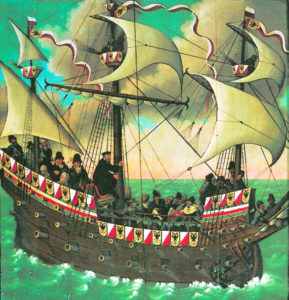Sailors, merchants and priests: people on board the ships heading North
Bart Holterman, 13 May 2016
The general history of the northern German trade with the North Atlantic is relatively well known but we know very little about the persons involved in this trade. This is especially true for the men that manned and sailed the ships that headed North.
Luckily, there are a couple of sources pertaining to the North Atlantic trade that give us a good insight into the people on board the ships. First, two boarding lists from Oldenburg for ships trading with Iceland in the 1580s have survived. Second, there is the magnificent book of donations of the Hamburg confraternity of St Anne, the socio-religious organisation behind the trade with Iceland, Shetland, and the Faroe Islands. From the 1530s onwards, the register lists the alms spent to the confraternity by the people on board of nearly every ship that returned to Hamburg, resulting in a more or less complete register of boarding lists.

On board a sixteenth-century ship: detail of the epitaph for the ship´s priest Sweder Hoyer (deceased 1565) from the St Jacob church in Lübeck. Note: this image does not necessarily reflect the situation on board the merchant ships in the North Atlantic.
From these sources we can learn that the number of people on board varied greatly, ranging from 77 on larger ships up to around 10 on board the smallest vessels. For Iceland, it was not uncommon to have more than 25 people on board. Ships sailing to Shetland and the Faroe Islands had less people on board, usually 15-20.
This difference in number of people on board was mainly caused by the number of merchants on board. The sizes of the crews were relatively similar on each ship, because 10 to 15 people were needed to sail the ship, regardless of its size. A typical crew consisted of:
– Skipper (schipper). He was the captain, the leader of the ship, often also one of the merchants, and (partly) shipowner.
– Helmsman (sturman), the one who steered the ship and had navigational knowledge.
– Chief boatswain (hovetbosman), the leader of the sailors.
– Schimman, the officer responsible for rigging and other technical things.
– Cook (koch).
– Carpenter (tymmerman), responsible for repairs to the ship.
– Gunner (buchsenschut), responsible for the defense of the ship.
– Barber (bartscher), who had medical knowledge, but lacked on most ships.
– 2-4 sailors (bosman).
– 1-2 ship boys (putker), young sailors in training.
Besides these, ships transported merchants and their servants, falcon catchers, priests, and passengers from the islands which used the regular traffic to travel to and from the European mainland.
Further reading:
B. Holterman, Size and composition of ship crews in the German trade with the North Atlantic islands. In: N. Mehler (ed.), Traveling to Shetland, Faroe and Iceland in the early modern period (Leiden, in press).
F. C. Koch, Untersuchungen über den Aufenthalt von Isländern in Hamburg für den Zeitraum 1520-1662. Beiträge zur Geschichte Hamburgs 49 (Hamburg 1995).